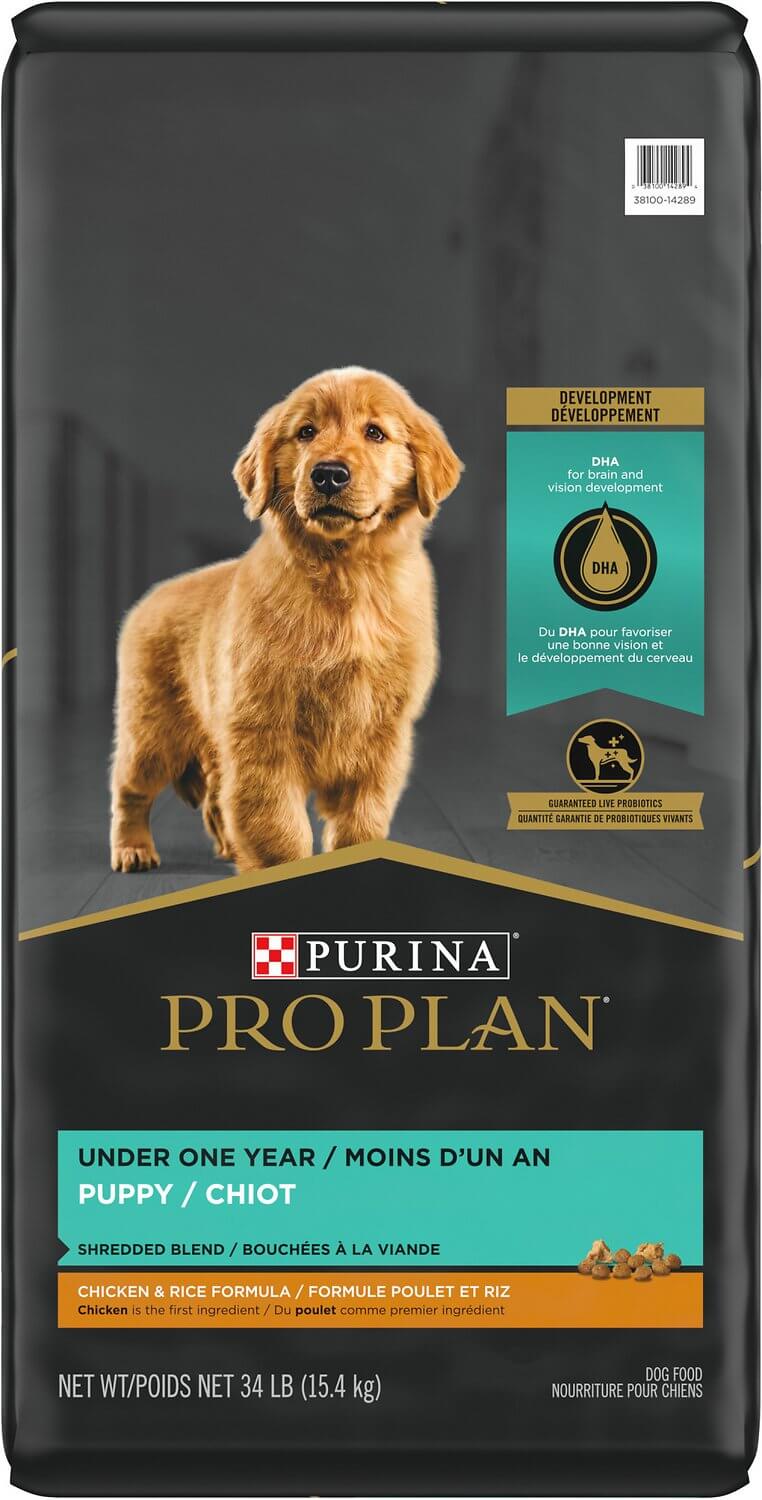
DogFoodAdvisor is reader supported See how
All reviews are 100% impartial but if you buy using links on this page, we may earn a referral fee.
Our Verdict
Purina Pro Plan Puppy product range is made up of 10 recipes with ratings varying from 3.5 to 4 stars. The average rating of the whole range is 4 stars.
The table below shows each recipe in this range including our rating and the AAFCO nutrient profile: Growth (puppy), Maintenance (adult), All Life Stages, Supplemental or Unspecified.
Recipe and Label Analysis
Purina Pro Plan Puppy Large Breed Chicken and Rice was selected to represent the other products in the line for detailed recipe and nutrient analysis.
Label and nutrient data below are calculated using dry matter basis.
Purina Pro Plan Puppy Large Breed Chicken and Rice
Estimated Dry Matter Nutrient Content
Protein
Fat
CarbsCarbohydrates
Chicken, rice, corn gluten meal, whole grain corn, poultry by-product meal, whole grain wheat, beef fat preserved with mixed-tocopherols, pea fiber, dried egg product, fish meal, natural flavor, fish oil, soybean oil, mono and dicalcium phosphate, salt, calcium carbonate, potassium chloride, potassium citrate, choline chloride, l-lysine monohydrochloride, minerals [zinc sulfate, ferrous sulfate, manganese sulfate, copper sulfate, calcium iodate], sodium selenite, vitamins [vitamin E supplement, niacin (vitamin B-3), vitamin A supplement, calcium pantothenate (vitamin B-5), thiamine mononitrate (vitamin B-1), vitamin B-12 supplement, riboflavin supplement (vitamin B-2), pyridoxine hydrochloride (vitamin B-6), folic acid (vitamin B-9), menadione sodium bisulfite complex (vitamin K), vitamin D-3 supplement, biotin (vitamin B-7)], garlic oil
Fiber (estimated dry matter content) = 4.75%
Red denotes any controversial items
| Estimated Nutrient Content | |||
|---|---|---|---|
| Method | Protein | Fat | Carbs |
| Guaranteed Analysis | 28% | 13% | NA |
| Dry Matter Basis | 32% | 15% | 45% |
| Calorie Weighted Basis | 28% | 32% | 40% |
Ingredients Analysis
The first ingredient in this dog food is chicken. Although it is a quality item, raw chicken contains up to 73% water. After cooking, most of that moisture is lost, reducing the meat content to just a fraction of its original weight.
After processing, this item would probably account for a smaller part of the total content of the finished product.
The second ingredient is rice. Is this whole grain rice, brown rice or white rice? Since the word “rice” doesn’t tell us much, it’s impossible to judge the quality of this item.
The third ingredient is corn gluten meal. Gluten is the rubbery residue remaining once corn has had most of its starchy carbohydrate washed out of it.
Although corn gluten meal contains 60% protein, this ingredient would be expected to have a lower biological value than meat.
And less costly plant-based products like this can notably boost the total protein reported on the label — a factor that must be considered when judging the actual meat content of this dog food.
The fourth ingredient is corn. Corn is an inexpensive and controversial cereal grain. And aside from its energy content, this grain is of only modest nutritional value to a dog.
For this reason, we do not consider corn a preferred component in any dog food.
The next ingredient includes poultry by-product meal, a dry rendered product of slaughterhouse waste. It’s made from what’s left of slaughtered poultry after all the prime cuts have been removed.
In addition to organs, this item can also include feet, beaks, undeveloped eggs and almost anything other than prime skeletal muscle.
On the brighter side, by-product meals are meat concentrates and contain nearly 300% more protein than fresh poultry.
The quality of this ingredient can vary, depending on the caliber of the raw materials obtained by the manufacturer.
We consider poultry by-products slightly lower in quality than a single-species ingredient (like chicken by-products).
The sixth ingredient is wheat. Wheat is another cereal grain and subject to the same issues as corn (previously discussed).
The seventh item is beef fat. Beef fat (or tallow) is most likely obtained from rendering, a process similar to making soup in which the fat itself is skimmed from the surface of the liquid.
Although it may not sound very appetizing, beef fat is actually a quality ingredient.
The eighth ingredient is pea fiber, a mixture of both soluble and insoluble dietary fiber derived from pea hulls. Aside from the usual benefits of fiber, this agricultural by-product provides no other nutritional value to a dog.
The ninth ingredient includes dried egg product, a dehydrated form of shell-free eggs. Quality can vary significantly. Lower grade egg product can even come from commercial hatcheries — from eggs that have failed to hatch.
In any case, eggs are easy to digest and have an exceptionally high biological value.
From here, the list goes on to include a number of other items.
But to be realistic, ingredients located this far down the list (other than nutritional supplements) are not likely to affect the overall rating of this Purina product.
With 6 notable exceptions…
First, we find fish meal, another protein-rich meat concentrate.
Fish meal is typically obtained from the “clean, dried, ground tissue of undecomposed whole fish and fish cuttings” of commercial fish operations.1
Unfortunately, this particular item is anonymous. Because various fish contain different types of fats, we would have preferred to have known the source species.
Next, soybean oil is red flagged here only due to its rumored (yet unlikely) link to canine food allergies.
However, since soybean oil is high in omega-6 fatty acids and contains no omega-3’s, it’s considered less nutritious than flaxseed oil or a named animal fat.
In addition, garlic oil can be a controversial item. Although many favor the ingredient for its claimed health benefits, garlic has been linked to Heinz body anemia in dogs.2
So, one must weigh the potential benefits of feeding garlic against its proven tendency to cause subclinical damage to the red blood cells of the animal.
Next, this recipe contains sodium selenite, a controversial form of the mineral selenium. Sodium selenite appears to be nutritionally inferior to the more natural source of selenium found in selenium yeast.
We also note that the minerals listed here do not appear to be chelated. And that can make them more difficult to absorb. Chelated minerals are usually associated with higher quality dog foods.
And lastly, this dog food includes menadione, a controversial form of vitamin K linked to liver toxicity, allergies and the abnormal break-down of red blood cells.
Since vitamin K isn’t required by AAFCO in either of its dog food nutrient profiles, we question the use of this substance in any canine formulation.
Nutrient Analysis
Based on its ingredients alone, Purina Pro Plan Puppy looks like an average dry dog food.
The dashboard displays a dry matter protein reading of 32%, a fat level of 15% and estimated carbohydrates of about 45%.
As a group, the brand features an average protein content of 33% and a mean fat level of 19%. Together, these figures suggest a carbohydrate content of 40% for the overall product line.
And a fat-to-protein ratio of about 58%.
Which means this Purina product line contains…
Above-average protein. Above-average fat. And below-average carbs when compared to a typical dry dog food.
When you consider the protein-boosting effect of the corn gluten meal in this recipe and the corn germ and soybean meals, pea protein and other plant-based protein boosters in other recipes, this looks like the profile of a dry dog food containing a moderate amount of meat.
Purina Dog Food Recall History
The following automated list (if present) includes all dog food recalls related to Purina through December 2025.
You can view a complete list of all dog food recalls since 2009 here.
Our Rating of Purina Dog Food
Purina Pro Plan Puppy is a grain-inclusive dry dog food using a moderate amount of named meat and by-product meals as its dominant source of animal protein, thus earning the brand 4 stars.
However, it’s unfortunate the company chose to include menadione in its recipe. Without this controversial ingredient and minus the plant-based protein boosters, we may have been compelled to award this line a higher rating.
Also, those concerned about the presence of menadione in this recipe may wish to ignore our rating and look elsewhere for a different product. Or consider using diet rotation to reduce the risks associated with feeding the same dog food… continuously, for a lifetime.
Compare Purina Dog Food
How does Purina compare with The Dog Food Advisor's most recommended brands?
Sources
A Final Word
The Dog Food Advisor does not accept money, gifts, samples or other incentives in exchange for special consideration in preparing our reviews.
However, we do receive a referral fee from online retailers (like Chewy or Amazon) and from sellers of perishable pet food when readers click over to their websites from ours. This helps cover the cost of operation of our free blog. Thanks for your support.
For more information, please visit our Disclaimer and Disclosure page.






